Bones Study guides, Class notes & Summaries
Looking for the best study guides, study notes and summaries about Bones? On this page you'll find 28492 study documents about Bones.
Popular textbooks 'Bones'
Bare Bones
Michael W. Warren, Nicolette M. Parr, Carlos J. Zambrano, Katherine E. Skorpinski
44 documents

The Anatomy and Physiology of the Human Body. Containing the Anatomy of the Bones, Muscles, and Joints; and the Heart and Arteries
Charles Bell, John Bell
1 documents
All 28.492 results
Sort by
 Popular
Popular
-
TEST BANK PHARMACOTHERAPEUTICS FOR ADVANCED PRACTICE NURSE PRESCRIBERS 5TH EDITION BY TERI MOSER WOO & MARYLOU V. ROBINSON
- Exam (elaborations) • 243 pages • 2023
-
- $15.99
- 9x sold
- + learn more
Pharmacotherapeutics for Advanced Practice Nurse Prescribers 5th Edition Woo & Robinson Test Bank UNIT I. THE FOUNDATION Chapter 1. The Role of the Nurse Practitioner as Prescriber Chapter 2. Review of the Basic Principles of Pharmacology Chapter 3. Rational Drug Selection Chapter 4. Legal and Professional Issues in Prescribing Chapter 5. Adverse Drug Reactions Chapter 6. An Introduction to Pharmacogenetics Chapter 7. Nutrition and Neutraceuticals Chapter 8. Herbal Therapies and Can...
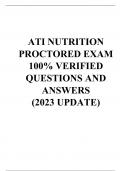 Popular
Popular
-
ATI Nutrition Proctored Exam 100% Verified Questions and Answers (2023 Update)
- Exam (elaborations) • 35 pages • 2023 Popular
-
Available in package deal
-
- $18.99
- 6x sold
- + learn more
A nurse is reinforcing diet teaching to a client who has type 2 DM. Which of the following should the nurse include in the teaching? Select all that apply. A. Carbs should comprise 55% of daily caloric intake B. Use hydrogenated oils for cooking C. Table sugar may be added to cereals D. Drink an alcoholic beverage w/meals E. Protein foods can be substituted for carb foods A nurse is reviewing dietary guidelines to include in the plan of care for a client who has type 2 DM. Which of ...
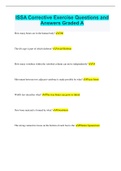
-
ISSA Corrective Exercise Questions and Answers Graded A
- Exam (elaborations) • 38 pages • 2023
-
Available in package deal
-
- $9.99
- 12x sold
- + learn more
ISSA Corrective Exercise Questions and Answers Graded A How many bones are in the human body? 206 The rib cage is part of which skeleton? Axial Skeleton How many vertebrae within the vertebral column can move independently? 24 Movement between two adjacent vertebrae is made possible by what? Facet Joints Wolffs law describes what? The way bones can grow or shrink New bone material is formed by what? Osteoblasts The strong connective tissue on the bottom of each foot is the: Plantar Aponeur...

-
Hawaii Massage Exam Practice Test 2024 Questions and Answers 100% Correct
- Exam (elaborations) • 60 pages • 2024
-
Available in package deal
-
- $14.99
- 2x sold
- + learn more
Hawaii Massage Exam Practice Test 2024 Questions and Answers 100% CorrectHawaii Massage Exam Practice Test 2024 Questions and Answers 100% CorrectHawaii Massage Exam Practice Test 2024 Questions and Answers 100% Correct The basic unit of structure of bones is the: (a) compact bones (b) periosteum (c) spongy bones (d) osteon - ANSWER-Osteon Which cranial nerve controls the shoulder? (a) vagus (b) trigeminal (c) accessory (d) abducens - ANSWER-Accessory Your client is lying in the s...
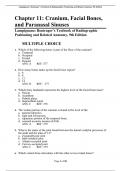
-
Chapter 11: Cranium, Facial Bones, and Paranasal Sinuses Lampignano: Bontrager’s Textbook of Radiographic Positioning and Related Anatomy, 9th Edition
- Exam (elaborations) • 30 pages • 2023
-
Available in package deal
-
- $3.58
- 1x sold
- + learn more
Chapter 11: Cranium, Facial Bones, and Paranasal Sinuses Lampignano: Bontrager’s Textbook of Radiographic Positioning and Related Anatomy, 9th Edition MULTIPLE CHOICE 1. Which of the following bones is part of the floor of the cranium? a. Temporal b. Occipital c. Frontal d. Parietal ANS: A REF: 377 2. How many bones make up the facial bone region? a. 6 b. 8 c. 12 d. 14 ANS: D REF: 377 3. Which bony landmark represents the highest level of the facial bone mass? a. Nasi...
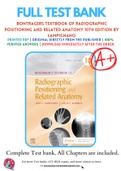
-
Test Bank for Bontrager's Textbook of Radiographic Positioning and Related Anatomy 10th Edition By John Lampignano; Leslie E. Kendrick Chapter 1-20 Complete Guide A+
- Exam (elaborations) • 357 pages • 2022
-
- $26.49
- 13x sold
- + learn more
Test Bank for Bontrager's Textbook of Radiographic Positioning and Related Anatomy 10th Edition By John Lampignano; Leslie E. Kendrick Chapter 1-20 Complete Guide A+ 9565, 9 6548, 6 1. Terminology, Positioning, and Imaging Principles 2. Chest 3. Abdomen 4. Upper Limb 5. Humerus and Shoulder Girdle 6. Lower Limb 7. Femur and Pelvic Girdle 8. Cervical and Thoracic Spine 9. Lumbar Spine, Sacrum, and Coccyx 10. Bony Thorax—Sternum and Ribs 11. Cranium, Facial B...
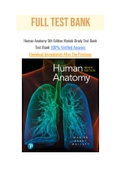
-
Human Anatomy 9th Edition Marieb Brady Test Bank
- Exam (elaborations) • 414 pages • 2022
-
- $24.48
- 28x sold
- + learn more
TEST BANK FOR HUMAN ANATOMY 9TH EDITION ELAINE N. MARIEB PATRICIA M. BRADY JON B. MALLATT ISBN-13: 4817 Human Anatomy, 9e (Marieb/Wilhelm/Mallatt) Table of Contents 1. The Human Body: An Orientation 2. Cells: The Living Units 3. Basic Embryology 4. Tissues 5. The Integumentary System 6. Bones and Skeletal Tissues 7. Bones, Part 1: The Axial Skeleton 8. Bones, Part 2: The Appendicular Skeleton 9. Joints 10. Skeletal Muscle Tissue 11. Muscles of the Body 12. Fundamentals of the Nervous System and ...
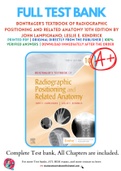
-
Test Bank for Bontrager's Textbook of Radiographic Positioning and Related Anatomy 10th Edition By John Lampignano; Leslie E. Kendrick Chapter 1-20 Complete Guide A+
- Exam (elaborations) • 357 pages • 2022
-
- $24.74
- 9x sold
- + learn more
Test Bank for Bontrager's Textbook of Radiographic Positioning and Related Anatomy 10th Edition By John Lampignano; Leslie E. Kendrick Chapter 1-20 Complete Guide A+ 9565, 9 6548, 6 1. Terminology, Positioning, and Imaging Principles 2. Chest 3. Abdomen 4. Upper Limb 5. Humerus and Shoulder Girdle 6. Lower Limb 7. Femur and Pelvic Girdle 8. Cervical and Thoracic Spine 9. Lumbar Spine, Sacrum, and Coccyx 10. Bony Thorax—Sternum and Ribs 11. Cranium, Facial B...

-
Test bank For Memmler's The Human Body in Health and Disease, Enhanced Edition 14th Edition by Barbara Janson Cohen; Kerry L. Hull 9781284217964 Chapter 1- 25 Complete Guide .
- Exam (elaborations) • 598 pages • 2022
-
- $24.42
- 15x sold
- + learn more
Test bank For Memmler's The Human Body in Health and Disease, Enhanced Edition 14th Edition by Barbara Janson Cohen; Kerry L. Hull 7964, 5 ,4471, 9 1 Organization of the Human Body 2 Chemistry, Matter, and Life 3 Cells and Their Functions 4 Tissues, Glands, and Membranes 5 Disease and Disease-Producing Organisms 6 The Integumentary System 7 The Skeletal System: Bones and Joints 8 The Muscular System 9 The Nervous System: The Spinal Cord and Spinal Nerves 10 The Ner...
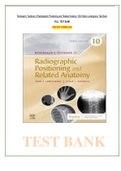
-
Test Bank for Bontragers Textbook of Radiographic Positioning and Related Anatomy 10th Edition by Lampignano.||ISBN NO:10,0323653677||ISBN NO:13,978-0323653671||All Chapters||Complete Guide A+
- Exam (elaborations) • 338 pages • 2023
-
- $24.99
- 43x sold
- + learn more
Test Bank for Bontragers Textbook of Radiographic Positioning and Related Anatomy 10th Edition by Lampignano. Test Bank for Bontragers Textbook of Radiographic Positioning and Related Anatomy 10th Edition by Lampignano.Test Bank for Bontragers Textbook of Radiographic Positioning and Related Anatomy 10th Edition by Lampignano. Test Bank for Bontragers Textbook of Radiographic Positioning and Related Anatomy 10th Edition by Lampignano. Test Bank for Bontragers Textbook of Radiographic Positioning...
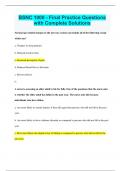
-
BSNC 1000 - Final Practice Questions with Complete Solutions
- Exam (elaborations) • 35 pages • 2023
- Available in package deal
-
- $10.99
- 2x sold
- + learn more
BSNC 1000 - Final Practice Questions with Complete Solutions Normal age-related changes in the nervous system can include all of the following except which one? a. Changes in sleep patterns b. Delayed reaction time c. Increased perception of pain d. Reduced blood flow to the brain e. Slower reflexes C. A nurse is assessing an older adult's risk for falls. One of the questions that the nurse asks is whether the older adult has fallen in the past year. The nurse asks this because individua...
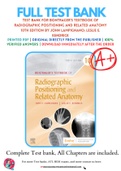
-
Test bank For Bontrager's Textbook of Radiographic Positioning and Related Anatomy 10th Edition by John Lampignano; Leslie E. Kendrick 9780323749565 Chapter 1-20 Complete Guide A+
- Exam (elaborations) • 357 pages • 2022
-
- $27.88
- 8x sold
- + learn more
Test bank For Bontrager's Textbook of Radiographic Positioning and Related Anatomy 10th Edition by John Lampignano; Leslie E. Kendrick 9565, 9 ,6548, 6 1. Terminology, Positioning, and Imaging Principles 2. Chest 3. Abdomen 4. Upper Limb 5. Humerus and Shoulder Girdle 6. Lower Limb 7. Femur and Pelvic Girdle 8. Cervical and Thoracic Spine 9. Lumbar Spine, Sacrum, and Coccyx 10. Bony Thorax—Sternum and Ribs 11. Cranium, Facial Bones, and Paranasal Sinuses 12...

That summary you just bought made someone very happy. Also get paid weekly? Sell your study resources on Stuvia! Discover all about earning on Stuvia



